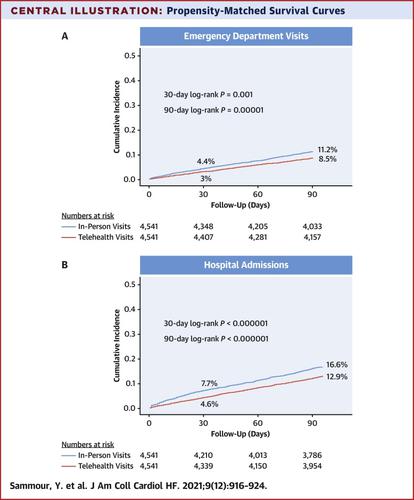JACC: Heart Failure ( IF 13.0 ) Pub Date : 2021-10-06 , DOI: 10.1016/j.jchf.2021.07.003 Yasser Sammour 1 , John A Spertus 1 , Bethany A Austin 1 , Anthony Magalski 1 , Sanjaya K Gupta 1 , Islam Shatla 1 , Evelyn Dean 1 , Kevin F Kennedy 1 , Philip G Jones 1 , Michael E Nassif 1 , Michael L Main 1 , Brett W Sperry 1

|
Objectives
This study sought to determine whether the increased use of telehealth was associated with a difference in outcomes for outpatients with heart failure.
Background
The COVID-19 pandemic led to dramatic changes in the delivery of outpatient care. It is unclear whether increased use of telehealth affected outcomes for outpatients with heart failure.
Methods
In March 2020, a large Midwestern health care system, encompassing 16 cardiology clinics, 16 emergency departments, and 12 hospitals, initiated a telehealth-based model for outpatient care in the setting of the COVID-19 pandemic. A propensity-matched analysis was performed to compare outcomes between outpatients seen in-person in 2018 and 2019 and via telemedicine in 2020.
Results
Among 8,263 unique patients with heart failure with 15,421 clinic visits seen from March 15 to June 15, telehealth was employed in 88.5% of 2020 visits but in none in 2018 or 2019. Despite the pandemic, more outpatients were seen in 2020 (n = 5,224) versus 2018 and 2019 (n = 5,099 per year). Using propensity matching, 4,541 telehealth visits in 2020 were compared with 4,541 in-person visits in 2018 and 2019, and groups were well matched. Mortality was similar for telehealth and in-person visits at both 30 days (0.8% vs 0.7%) and 90 days (2.9% vs 2.4%). Likewise, there was no excess in hospital encounters or need for intensive care with telehealth visits.
Conclusions
A telehealth model for outpatients with heart failure allowed for distanced encounters without increases in subsequent acute care or mortality. As the pressures of the COVID-19 pandemic abate, these data suggest that telehealth outpatient visits in patients with heart failure can be safely incorporated into clinical practice.
中文翻译:

采用远程医疗模式后 COVID-19 大流行期间心力衰竭的门诊管理
目标
本研究旨在确定远程医疗使用的增加是否与心力衰竭门诊患者的结局差异有关。
背景
COVID-19 大流行导致门诊服务的提供发生了巨大变化。目前尚不清楚远程医疗的增加是否会影响心力衰竭门诊患者的预后。
方法
2020 年 3 月,一个大型的中西部医疗保健系统(包括 16 个心脏病诊所、16 个急诊科和 12 家医院)在 COVID-19 大流行的背景下启动了基于远程医疗的门诊护理模式。进行了倾向匹配分析,以比较 2018 年和 2019 年门诊患者和 2020 年远程医疗门诊患者的结果。
结果
从 3 月 15 日到 6 月 15 日,在 8,263 名独特的心力衰竭患者中,有 15,421 次就诊,其中 88.5% 的 2020 年就诊使用了远程医疗,但在 2018 年或 2019 年没有使用。尽管发生了大流行,但 2020 年看到了更多的门诊患者(n = 5,224 ) 与 2018 年和 2019 年(每年 n = 5,099)相比。使用倾向匹配,将 2020 年的 4,541 次远程医疗访问与 2018 年和 2019 年的 4,541 次亲自访问进行了比较,并且组匹配良好。远程医疗和亲自就诊在 30 天(0.8% 对 0.7%)和 90 天(2.9% 对 2.4%)的死亡率相似。同样,医院就诊或远程医疗就诊的重症监护需求也没有增加。
结论
心力衰竭门诊患者的远程医疗模式允许远距离就诊,而不会增加随后的急性护理或死亡率。随着 COVID-19 大流行的压力减弱,这些数据表明,心力衰竭患者的远程医疗门诊可以安全地纳入临床实践。



























 京公网安备 11010802027423号
京公网安备 11010802027423号